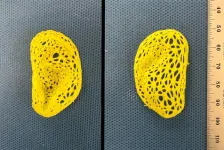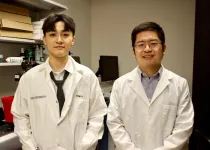(Press-News.org) Researchers Produce Grafts that Replicate the Human Ear
Using state-of-the-art tissue engineering techniques and a 3D printer, researchers at Weill Cornell Medicine and Cornell Engineering have assembled a replica of an adult human ear that looks and feels natural. The study, published online in Acta Biomaterialia on March 16, offers the promise of grafts with well-defined anatomy and the correct biomechanical properties for those who are born with a congenital malformation or who lose an ear later in life.
“Ear reconstruction requires multiple surgeries and an incredible amount of artistry and finesse,” said, Dr. Jason Spector, chief of the Division of Plastic and Reconstructive Surgery at NewYork-Presbyterian/Weill Cornell Medical Center and a professor of surgery (plastic surgery) at Weill Cornell Medicine. “This new technology may eventually provide an option that feels real for thousands needing surgery to correct outer ear deformities.”
Many surgeons build a replacement ear using cartilage removed from a child’s ribs, an operation that can be painful and scarring. And though the resulting graft can be crafted to resemble the recipient’s other ear, it generally does not have the same flexibility.
Adding Texture to Structure
One way to produce a more natural replacement ear is to enlist the aid of chondrocytes, the cells that build cartilage. In earlier studies, Dr. Spector and his colleagues used animal-derived chondrocytes to seed a scaffold made of collagen, a key component of cartilage. Though these grafts developed successfully at first, over time the well-defined topography of the ear—its familiar ridges, curves, and whorls—were lost. “Because the cells tug on the woven matrix of proteins as they labor, the ear contracted and shrank by half,” said Dr. Spector.
To address this problem in this study, Dr. Spector and his team used sterilized animal-derived cartilage treated to remove anything that could trigger immune rejection. This was loaded into intricate, ear-shaped plastic scaffolds that were created on a 3D printer based on data from a person’s ear. The small pieces of cartilage act as internal reinforcements to induce new tissue formation within the scaffold. Much like rebar, it strengthens the graft and prevents contraction.
Over the next three to six months, the structure developed into cartilage containing tissue that closely replicated the ear’s anatomical features, including the helical rim, the “anti-helix” rim-inside-the-rim and the central, conchal bowl. “That’s something that we had not achieved before,” said Dr. Spector.
To test the feel of the ear, biomechanical studies were performed in conjunction with Dr. Spector's long time engineering collaborator Dr. Larry Bonassar, the Daljit S. and Elaine Sarkaria Professor in Biomedical Engineering at the Meinig School of Biomedical Engineering on Cornell’s Ithaca campus. This confirmed that the replicas had flexibility and elasticity similar to human ear cartilage. However, the engineered material was not as strong as natural cartilage and could tear.
To remedy this issue, Dr. Spector plans to add chondrocytes to the mix, ideally ones derived from a small piece of cartilage removed from the recipient’s other ear. Those cells would lay down the elastic proteins that make ear cartilage so robust, producing a graft that would be biomechanically much more similar to the native ear, he said.
This work was supported in part by the National Center for Advancing Translational Sciences of the National Institutes of Health, grant TL1- TR-002386.
Many Weill Cornell Medicine physicians and scientists maintain relationships and collaborate with external organizations to foster scientific innovation and provide expert guidance. The institution makes these disclosures public to ensure transparency. For this information, please see the profile for Dr. Spector.
END
Researchers produce grafts that replicate the human ear
2024-03-29
ELSE PRESS RELEASES FROM THIS DATE:
Hevolution Foundation issues $115 million call for applications for geroscience research opportunities
2024-03-29
BOSTON, United States — 29 March, 2024 — Based on the success of its 2023 HF-GRO program effort, Hevolution Foundation is issuing a call for applications for the 2024 iteration of the program. HF-GRO is an international effort to accelerate progress in healthy aging research. The major goal is to identify and support research that will further the Hevolution’s mission of extending healthy lifespan for the benefit of all humanity.
HF-GRO will ...
Rice study identifies protein responsible for gas vesicle clustering in bacteria
2024-03-29
HOUSTON – (March 29, 2024) – Gas vesicles are hollow structures made of protein found in the cells of certain microorganisms, and researchers at Rice University believe they can be programmed for use in biomedical applications.
“Inside cells, gas vesicles are packed in a beautiful honeycomb pattern. How this pattern is formed has never been thoroughly understood. We are presenting the first identification of a protein that can regulate this patterning, and we believe this will be a milestone in molecular microbiology,” said George Lu, assistant professor of bioengineering and a Cancer Prevention and Research Institute of Texas scholar.
Lu and colleagues have published ...
AADOCR announces recipients of the 2024 Student Competition for Advancing Dental Research Application (SCADA)
2024-03-29
Alexandria, VA – The American Association for Dental, Oral, and Craniofacial Research (AADOCR) has named the recipients of the 2024 Student Competition for Advancing Dental Research Application (SCADA). The recipients were recognized during the Opening Ceremonies of the 53rd Annual Meeting of the AADOCR, which was held in conjunction with the 102nd General Session of the International Association for Dental, Oral, and Craniofacial Research and the 48th Annual Meeting of the Canadian Association for Dental Research, on March 13-16, 2024 in New Orleans, LA.
The winners are:
CLINICAL RESEARCH & PUBLIC HEALTH CATEGORY
1st ...
Veterans help provide greater insight into Klinefelter and Jacobs syndromes
2024-03-29
AURORA, Colo. (March 29, 2024) –Researchers at the University of Colorado Anschutz Medical Campus and collaborators across the country have conducted the largest and most diverse study of men with extra X or Y chromosomes in the US using a large dataset of military veterans. The results could lead to better diagnoses of these underrecognized conditions and earlier treatment of associated diseases.
The study was published today in JAMA Network Open.
“One in 400 males have an additional X or Y chromosome, however 86 percent of these individuals are not diagnosed,” said ...
Three renowned Argonne scientists accept joint appointments at the University of Houston
2024-03-29
HOUSTON, March 29, 2024 – Three top researchers with the U.S. Department of Energy’s Argonne National Laboratory have accepted joint appointments in various capacities at the University of Houston. These appointments are part of the memorandum of understanding (MoU) Argonne signed recently with the Greater Houston Partnership. The MoU creates greater collaboration across academia, industry, private investors and government to accelerate and scale decarbonization efforts in the region, with the goal of achieving a net-zero emissions economy by 2050, according to an Argonne press release.
“This strategic collaboration leverages the combined strengths ...
High-resolution images reveal similarities in protein structures between Alzheimer’s disease and Down syndrome
2024-03-29
INDIANAPOLIS – More than 90% of people with Down syndrome, the most common chromosomal disorder in humans and the most frequent genetic cause of intellectual disability, are diagnosed with Alzheimer’s disease by ages 55-60. A new study recently published in Nature Structural and Molecular Biology uses leading-edge cryo-electron microscopy imaging technology to determine whether differences exist between the protein structures in those with Alzheimer’s disease and those with both Alzheimer’s disease and Down syndrome.
“Just like in Alzheimer’s disease, the neuropathological phenotype in those with ...
How blocking a neural receptor responsible for addiction could reduce alcohol use
2024-03-29
LA JOLLA, CA—Scripps Research scientists have found that LY2444296—a compound that selectively blocks the kappa opioid receptor (KOP)—may reduce drinking in cases of alcohol dependence in animal studies. The findings, which were published March 9, 2024, in Scientific Reports, could eventually inform new treatment options for people who experience alcohol use disorder (AUD).
“Compounds designed to selectively block the KOP are very promising because this receptor is involved in a lot of mental illnesses, such as ...
Researchers discover skin biomarkers in infants that predict early development of food allergies
2024-03-29
DENVER — (MARCH 29, 2024) Food allergies occur often in childhood and can be severe or even fatal. Researchers at National Jewish Health are working to develop a program to prevent food allergies and have now identified early predictors of the condition.
During a recent study just published online in the March 2024 issue of the Journal of Allergy & Clinical Immunology, skin tape strips were collected from the forearms of newborns at the age of two months, an age before there ...
Researchers reveal evolutionary path of important proteins
2024-03-29
New research from the University of Wisconsin–Madison decodes the evolutionary pathway of regulatory proteins, the molecules that help control gene expression.
The findings from the Raman Lab in the Department of Biochemistry recently published their findings in the journal Cell Systems. Here’s a rundown on what they discovered:
Proteins acquire and lose functions through evolutionary processes as cells adapt to changes in their environment over time.
Protein evolution is well studied in certain enzymes but is understudied in regulatory proteins, which help control gene expression.
A new, ...
Insilico Medicine presents progress of 5 novel AI cancer drugs at AACR
2024-03-29
Insilico Medicine (“Insilico”), a clinical-stage generative artificial intelligence (AI)-driven drug discovery company, today announced that five preclinical programs have been accepted as poster presentations in the American Association for Cancer Research Annual Meeting 2024 (AACR 2024) happening April 5-10 in San Diego. Abstracts are now available on the AACR website.
Insilico’s drug discovery efforts are driven by its validated and commercially viable AI drug discovery platform, Pharma.AI, ...




